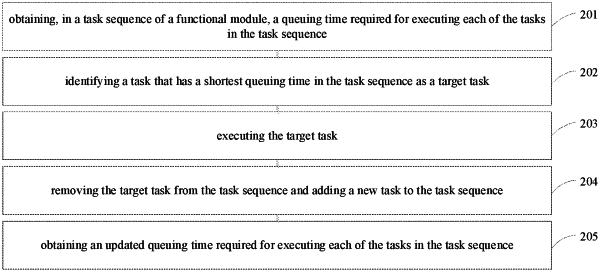| CPC H01L 21/67276 (2013.01) [G05B 19/4155 (2013.01); G06Q 10/06 (2013.01); G06Q 10/06316 (2013.01); G06Q 50/04 (2013.01); G05B 2219/34418 (2013.01); Y02P 90/02 (2015.11)] | 20 Claims |

|
1. A method for scheduling an apparatus, through a system that includes a processor and the apparatus, in a production line, the method comprising:
dividing, through the processor, the apparatus into a plurality of functional modules including at least two of an atmospheric robot, a loadlock, a vacuum robot, or a process chamber;
identifying and recording, through the processor, basic operations performed by each of the plurality of functional modules, and a task sequence of each of the plurality of functional modules including one or more tasks and each task corresponding to one of the basic operations, the task sequences of the plurality of functional modules include a threshold number, the threshold number indicating a maximum number of the tasks in the task sequence of each of the plurality of functional modules, and the threshold number of the plurality of functional modules being same;
recording, through a timer coupled to the processor, a processing time of each of the basic operations;
detecting, through the processor, states of the plurality of functional modules at a current time, the states including an idle state or a busy state of each of the plurality of functional modules;
calculating, through the timer coupled to the processor for the task sequence corresponding to each functional module of the plurality of functional modules, a queuing time of each task in the task sequence of each functional module required from the current time to a time for executing each of the tasks in the task sequence, wherein calculating the queuing time of each task in the task sequence of each functional module includes:
acquiring a first time required for the functional module to enter the idle state, the first time including a time for the functional module to complete a current task that the functional module currently performs;
acquiring a second time required to complete an adjustment operation for the task in the task sequence adjusted from the current task of the functional module, the adjustment operation being an operation between the current task and a next task;
acquiring a third time required to complete all preceding tasks of the next task in the task sequence of the functional module, the preceding tasks of the next task including one or more certain tasks in the process flow required to be performed by the functional module after the current task and before the next task;
and summing up the first time, the second time, and the third time to provide the queuing time;
for each of the at least two of the atmospheric robot, the loadlock, the vacuum robot, or the process chamber, determining, through the processor, a task that has a shortest queuing time in the task sequence as a target task of the each of the at least two of the atmospheric robot, the loadlock, the vacuum robot, or the process chamber, including:
comparing the queuing time of the tasks that are to be processed in the task sequences of the each of the at least two of the atmospheric robot, the loadlock, the vacuum robot, or the process chamber to obtain the shortest queuing time of the each of the at least two of the atmospheric robot, the loadlock, the vacuum robot, or the process chamber;
determining the task corresponding to the shortest queuing time as the target task that is to be processed of the each of the at least two of the atmospheric robot, the loadlock, the vacuum robot, or the process chamber;
controlling each of the at least two of the atmospheric robot, the loadlock, the vacuum robot, or the process chamber to process the target task that is to be processed of the each of the at least two of the atmospheric robot, the loadlock, the vacuum robot, or the process chamber after the target task is determined, to achieve a shortest overall queuing time of the production line, the target task of the each of the at least two of the atmospheric robot, the loadlock, the vacuum robot, or the process chamber including at least one of transmitting a wafer using the vacuum robot, transmitting the wafer using the atmospheric robot, pumping or exhausting the loadlock, or executing a process flow of the wafer using the process chamber;
and removing, through the processor, the target task from the task sequence of each of the at least two of the atmospheric robot, the loadlock, the vacuum robot, or the process chamber.
|